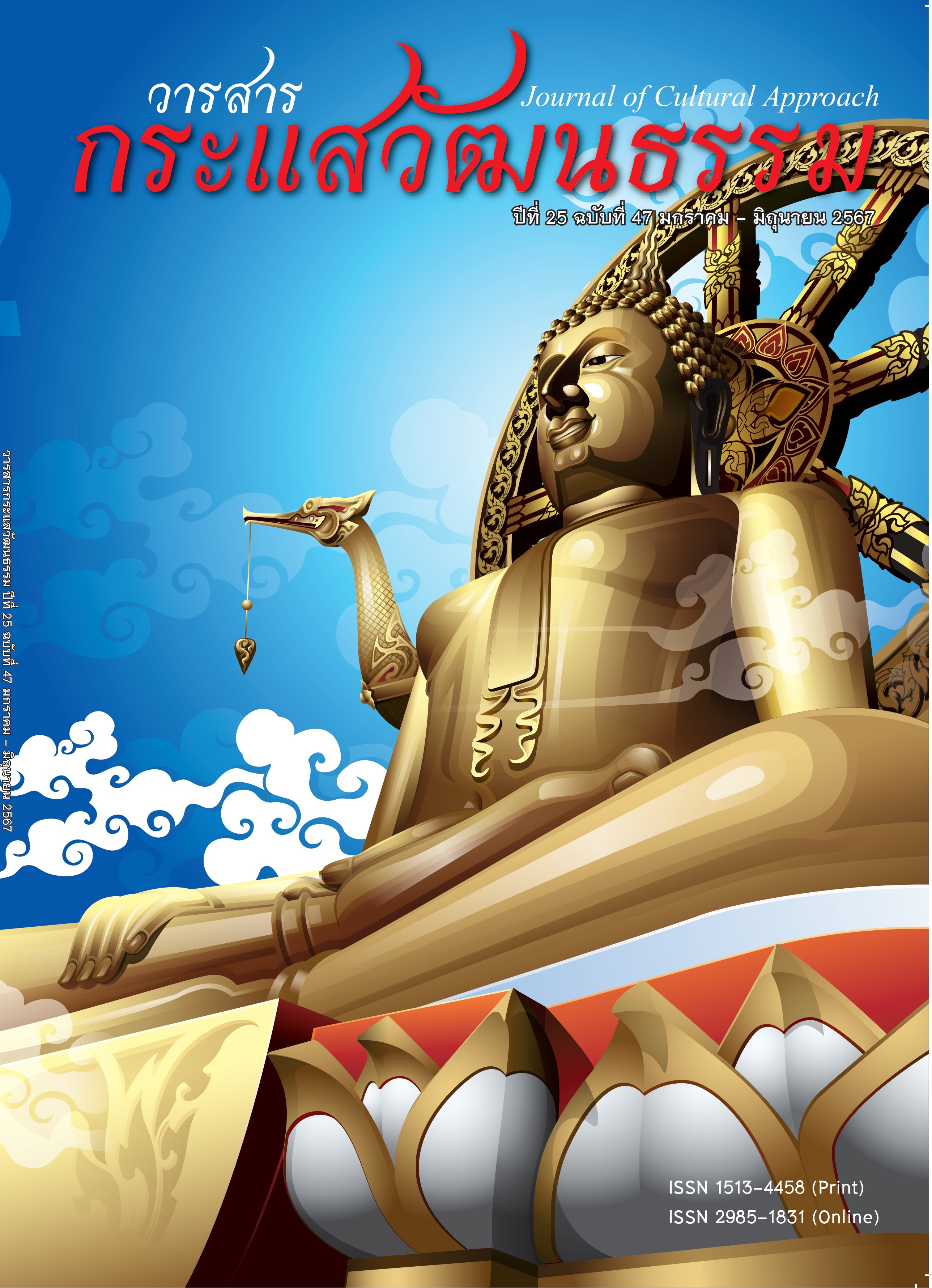สภาพการณ์และแนวโน้มสมรรถนะของช่างฝีมือแกะสลักในประเทศไทย
Main Article Content
บทคัดย่อ
งานวิจัยนี้มีวัตถุประสงค์ เพื่อศึกษาสภาพการณ์และแนวโน้มสมรรถนะของช่างฝีมือแกะสลักในประเทศไทย โดยการใช้การวิจัยเอกสาร และกระบวนวิธีการวิจัยเชิงคุณภาพ ด้วยวิธีการสัมภาษณ์เชิงลึกจากผู้เชี่ยวชาญ 18 คน เครื่องมือที่ใช้ในการวิจัยประกอบด้วยการใช้แนวคำถามการสัมภาษณ์ การวิเคราะห์ใช้วิธีการตรวจสอบสามเส้าด้านข้อมูล
ผลการวิจัยพบว่า 1) การศึกษางานแกะสลักของช่างฝีมือแกะสลักในประเทศไทยมีการจัดการศึกษานอกระบบ และการจัดการศึกษาในระบบวิธีการเรียนการสอนเรียนตั้งแต่ลายพื้นฐานง่าย ๆ จนถึงลวดลายขั้นสูง 2) การสืบทอดอาชีพงานแกะสลักของช่างแกะสลักในประเทศไทยมีอาชีพหลากหลาย เช่น รับราชการ/พนักงานของรัฐ พนักงานบริษัทเอกชน ธุรกิจส่วนตัว อาชีพอิสระ 3) อุปกรณ์ที่ใช้ของช่างฝีมือแกะสลักในประเทศไทยแบ่งออกเป็นอุปกรณ์หลักและอุปกรณ์เสริม 4) วัตถุดิบของช่างฝีมือแกะสลักในประเทศไทยแบ่งออกเป็นผักของไทย ผลไม้ของไทย ผักต่างประเทศ ผลไม้ต่างประเทศ 5) ลวดลายของช่างฝีมือแกะสลักในประเทศไทยแบ่งออกเป็นลวดลายขั้นต้น ลวดลายขั้นกลาง ลวดลายขั้นสูง 6) เทคนิคการแกะสลักของช่างฝีมือแกะสลักในประเทศไทย ประกอบด้วยการจับมีด การเลือกอุปกรณ์ เทคนิคการแกะสลักขั้นพื้นฐาน เทคนิคการแกะสลักขั้นกลาง เทคนิคการแกะสลักขั้นสูง 7) การดูแลรักษาผลงานแกะสลักของช่างฝีมือแกะสลักในประเทศไทย แบ่งออกเป็นระยะสั้น 1-2 วัน ระยะยาว 3-7 วัน และ8) ประโยชน์การนำงานแกะสลักไปใช้ของช่างฝีมือแกะสลักในประเทศไทย งานแกะสลักนำไปใช้เพื่อการบริโภค งานมงคล งานอวมงคล สามารถเป็นอาชีพในธุรกิจโรงแรม ภัตตาคาร ร้านอาหาร และการเผยแพร่วัฒนธรรม นอกจากนั้นสามารถสร้างอาชีพแกะสลักของที่ระลึกได้อีกด้วย
Article Details

อนุญาตภายใต้เงื่อนไข Creative Commons Attribution-NonCommercial-NoDerivatives 4.0 International License.
Proposed Creative Commons Copyright Notices
1. Proposed Policy for Journals That Offer Open Access
Authors who publish with this journal agree to the following terms:
- Authors retain copyright and grant the journal right of first publication with the work simultaneously licensed under a Creative Commons Attribution License that allows others to share the work with an acknowledgement of the work's authorship and initial publication in this journal.
- Authors are able to enter into separate, additional contractual arrangements for the non-exclusive distribution of the journal's published version of the work (e.g., post it to an institutional repository or publish it in a book), with an acknowledgement of its initial publication in this journal.
- Authors are permitted and encouraged to post their work online (e.g., in institutional repositories or on their website) prior to and during the submission process, as it can lead to productive exchanges, as well as earlier and greater citation of published work (See The Effect of Open Access).
Proposed Policy for Journals That Offer Delayed Open Access
Authors who publish with this journal agree to the following terms:
- Authors retain copyright and grant the journal right of first publication, with the work [SPECIFY PERIOD OF TIME] after publication simultaneously licensed under a Creative Commons Attribution License that allows others to share the work with an acknowledgement of the work's authorship and initial publication in this journal.
- Authors are able to enter into separate, additional contractual arrangements for the non-exclusive distribution of the journal's published version of the work (e.g., post it to an institutional repository or publish it in a book), with an acknowledgement of its initial publication in this journal.
- Authors are permitted and encouraged to post their work online (e.g., in institutional repositories or on their website) prior to and during the submission process, as it can lead to productive exchanges, as well as earlier and greater citation of published work (See The Effect of Open Access).
เอกสารอ้างอิง
Chaisri, A. (2020). Human Resource Management Based on Competency. Academic MCU Buriram Journal, 5(2), 234–248.
Department of Cultural Promotion (DCP). (2016). Traditional Craftsmanship: National Intangible Cultural Heritage. https://chantralibraryhome.files.wordpress.com/2019/07/publication12.pdf
Hongrattanavorakit, S. & Aitsarasuchip, K. (2022). Discourse Analysis: Maintaining Teaching Identity of Professor in Fruit and Vegetable Carving for Faculty of Home Economics Technology, Rajamangala University of Technology Phra Nakhon. Journal of Cultural Approach, 23(44), 34–46.
Hongrattanavorakit, S. & Chantakul, S. (2023). Role Perception of Carving Fruits and Vegetable Preservation. Journal of Cultural Approach, 24(45), 3–17.
Hongrattanavorakit, S. (2022). Contemporary Art of Fruit and Vegetable Carving. Journal of Cultural Approach, 23(44), 58–69.
Hongrattanavorakit, S. (2023). Fruit and Vegetable Carving: Value-Added to Thai Food. Journal of Thai Food Culture, 5(1), 51–60.
McClelland, D. C. (1973). Testing for Competence Rather than for Intelligence. American Psychologist, 28, 1–14.
Panprom, S. (2013). Fruits and Vegetable Carving; the Development of Carving Patterns for Food Decoration. Mahasarakham University.
Phakdeelikhit, L., Chunsakorn, P., Wattana, L. & Tharawanich, S. (2015). Sustainable Thai Goldsmith Knowledge Transfer. Princess of Naradhiwas University Journal, 7(1), 115–126.
Sawangsuk, P. (2012). Vegetable and Fruit Carving. Ramkhamhaeng University Press.
Sebsaithai, J. & Hongwityakorn, U. (2019). Knowledge Management to Enhance Competitive Capabilities of Thai Hairdressers. Journal of Education Studies, 47(1), 56–76.
Spencer, L. M. & Spencer, S. M. (1993). Competence at Work: Model for Superior Performance. Wiley & Sons.
Suriyakamol, S. (2016). A Model and A Learning Process to Develop Excellence in Carving Fruits and Vegetables: Case Study of Recipients of National Excellence Fair Awards. Srinakharinwirot University.
Suwannarak, J. & Rattanapanone, N. (2015). Fruit and Vegetable Carving Technology. Odeon Store.
Thepkit, M. (2013). The Body of Knowledge on Master of Wisdom in the Fine Arts: Women’s College in the Court. Veridian E–Journal, 6(2), 756–773.


